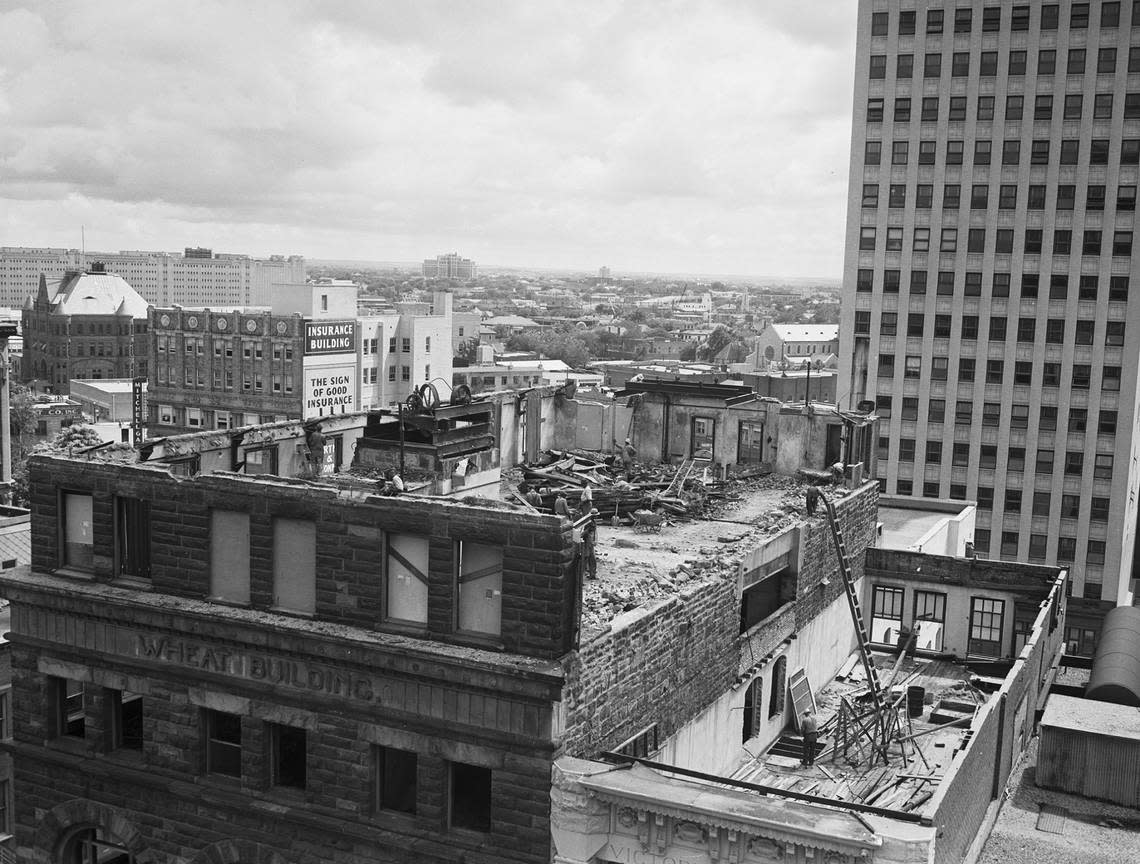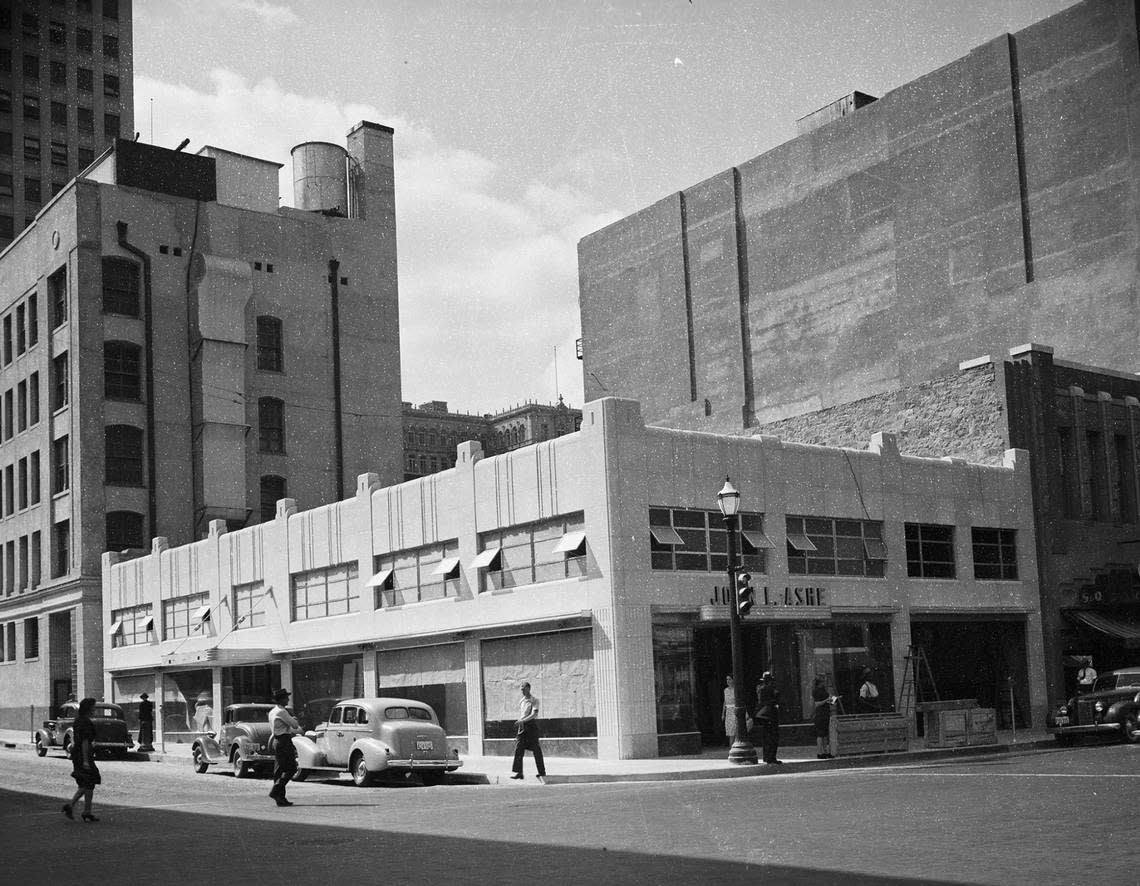The unlikely story of a gambler turned builder and the Wheat Building in Fort Worth
Joseph Zaharia Wheat was not born in Fort Worth, and he did not die here, nor did he live here a long time. He and his wife Virginia (“Virgie”) came to Fort Worth in 1885, and he died in 1906. But he left a huge imprint on his adopted city, mostly in the form of a magnificent namesake building, now barely remembered.
The Wheats came to Fort Worth from Kentucky. Joseph had little education and few marketable skills, but he quickly ingratiated himself with the saloon crowd, bending an elbow with them at the bar and joining their poker games. He became proprietor of a hotel on the courthouse square, though he thought of himself as a sport (gentleman gambler).
In 1901, he transformed into a self-described “builder and real estate man” when he acquired an empty building on the northwest corner of Eighth and Main, the site where Del Frisco’s steakhouse is today. Built in 1890 by Fort Worth Loan & Construction for more than $90,000 in a neo-Romanesque style, it had gone through tough times in the years since. The six-story structure was designed to be a headquarters for the wholesale dry goods firm of Martin-Brown, but Brown died before it could be finished, and Martin could not pay the contractor. Fort Worth Loan & Construction leased it out as warehouse space to other wholesalers. When the financial panic of 1895 hit, Fort Worth Loan & Construction went under. Legend has it the building changed hands in a poker game, but the winner had no use for it. What is certain is that the building passed to Merchants National Bank, which let it be auctioned off on the courthouse steps.
That is how Joseph Wheat acquired it for the bargain-basement price of $40,000. Wheat had no business to put in it, but he had big plans. He spent nearly $50,000 remodeling it into high-class office space that included a fire control system with a 5,000-gallon tank on the roof and fire hose connections on every floor.
Wheat transformed the roof of his building into the first rooftop garden restaurant west of the Mississippi. He added a canopied stage for nightly musical and comedy performances. To help fill the schedule, he formed his own acting troupe. The rooftop garden restaurant opened in the summer of 1902.
Because Wheat was still a “sport” at heart, he also added a saloon in the basement that he named the Stag Annex after a well-known place nearby. He advertised it as a “resort for gentlemen” and “the coolest place in the City,” which was stretching the truth since it lacked banks of windows to provide cross ventilation for patrons. Still, with his basement saloon and rooftop garden-restaurant-theater, Joseph Wheat turned a shabby warehouse into the in spot of Fort Worth nightlife. Even the building’s office space attracted high-end clients. One of the first tenants was New York Life Insurance Co., which put its Texas headquarters in the newly christened Wheat Building.
With its “skyscraper” height (by Fort Worth standards) and roof garden, the Wheat building was the city’s premier address. It got another distinction in 1904 when the De Forest Wireless Telegraph Co. placed one of the first transmission towers in Texas on the busy rooftop.
Joseph Wheat’s string of successes came to a halt at the end of the second season of the rooftop garden restaurant in 1903. The crowds had dropped dramatically after the novelty wore off. Another reason tail-off in popularity was because fickle Texas weather did not cooperate. Gusts of wind sent Stetsons and bonnets flying and palm trees crashing to the floor, and sudden showers drenched patrons before they could scramble to the stairwell.
But Wheat was far from out of ideas. He announced plans to add a seventh floor to the building where the roof garden had been. He spent more than $15,000 getting it to match the first six floors in design and stonework and adding marble wainscoting to the interior. He added a flourish in the space between the sixth and seventh floors: the name WHEAT BUILDING engraved in stone. Things began looking up when the Santa Fe Railroad moved in, taking up several floors at 808 Houston along with lawyers, insurance companies, and a bank.
Wheat took Virgie and their two daughters and moved to San Antonio in the fall of 1905 for what he called “business reasons,” though he retained extensive property holdings in Fort Worth. What was not widely known was that his health was failing. He and Virgie spent the summer of 1906 in the East (seeing doctors?). Perhaps seeing the end coming, he took out a life insurance policy for $100,000 and drew up his will. Less than two weeks after returning to San Antonio in November he was rushed to the hospital on Friday, Nov. 16, suffering from what was diagnosed as “pulmonary edema.” Doctors performed emergency surgery the next day, but he died three days later. He was just 51 years old.
Virgie had the body shipped back to Fort Worth for the funeral service. The Wheat Building tenants went together and sent a massive floral arrangement to the funeral. Interment followed in Oakwood Cemetery.
Joseph Wheat left a life insurance policy for $100,000 and property holdings worth an estimated $150,000. He left his wife and two daughters, Nell and Virginia, with an ironclad will, dated July 31, 1905. It named Virgie executrix but appointed three business associates as trustees to control his property holdings “as they see fit,” that is with one exception. The exception was his namesake building, which was now worth more than three times what he paid for it in 1901. On it he placed a deed restriction barring Virgie and her daughters from selling it, mortgaging it, or in any other way disposing of it “so long as they shall live.”
The restriction extended to the girls’ husbands and even their children while any of the three was alive. Only when all three were dead could the Wheat Building be disposed of. In return, they were free to enjoy whatever revenue the building bought in over the years to come. These were the unbreakable terms of a man determined to control his property even from beyond the grave.
That was the way things stood until 1935 when Virginia Wheat Finley and Nell Wheat Rowland brought suit to break the will, arguing that the “diminishing returns” of the “antique” building made it a white elephant. They wanted to demolish it for a modern office building.

Their lawsuit put them at odds with their mother initially though they eventually lined up on the same side – knocking it down. In 1940, the court found in their favor and granted a permit to raze the building. The Wheat Building came down that summer. In its place went a new, one-story building, the John L. Ashe Men’s Clothing Store, which had started many years before as a men’s shoe store.

In 1942 Virgie Wheat, in declining health, moved in with Rose Nell and husband at their home in Weslaco. She lived another 16 years, dying in her sleep on July 12, 1958. She was buried beside Joseph in Oakwood Cemetery.
Joseph Wheat lived an enviable, if preternaturally short, life. The building that bore his name, however, was star-crossed. One of its first owners died before it could be completed. Multiple owners who followed could not make a go of it and it passed into bankruptcy. The new owner’s fancy roof garden failed miserably, and while Joseph Wheat considered it the crown jewel in his real estate holdings, his tenants had their own issues with it. One of them died in 1915, falling down the elevator shaft. Other tenants were kicked out when the building was razed in 1940. By that date, it was a tired old eyesore, still standing only out of sheer orneriness.
Author-historian Richard Selcer is a Fort Worth native and proud graduate of Paschal High and TCU.
